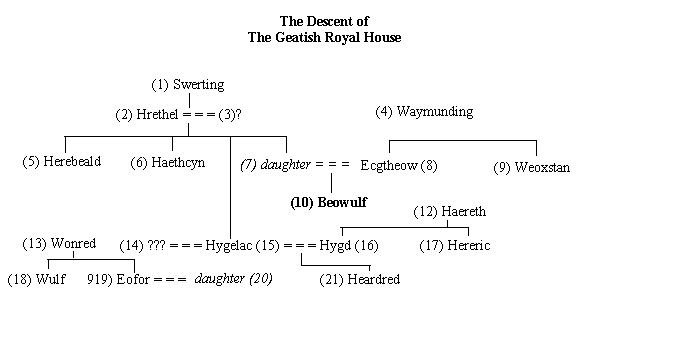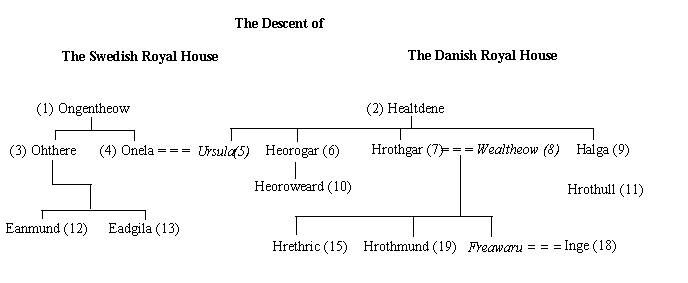
After the Flood, by Bill Cooper
Introduction
Virtually every edition of the Beowulf epic (and virtually every commentary on the poem), will take pains to assure the reader that what he is reading is not a historically accurate account of events or personages. Beowulf is described as a moral tale composed several centuries after the times of which it treats, a good yarn, and so on and so forth. What it does not do is embody real history. However, the best test for historicity that can be applied to any document from the past, be it chronicle, epic poem or prose narrative, is the test of its genealogies and personal names. Are the men and women mentioned in the work characters who are known to us from other contemporary sources? Can the genealogies be verified? If they can, then we are dealing with an account that we can rely on as history. If their information is demonstrably wrong or fictitious, and if it is seen to contradict other accepted historical sources, then clearly the rest of the matter can be dismissed as mere fiction. Thus, and in the light of the persistent modernist assertion that Beowulf is merely fiction, we shall examine the complex genealogies that are embodied within the poem in the sure knowledge that no compiler of fairy-stories ever went to such enormous lengths to add such circumstantial verisimilitude to his tale as we find in the Beowulf. The following evidence will speak for itself.
I have relied on Klaeber (3rd ed. see bibliography) for much of the information contained in the notes, and for the dates which, as he points out, are estimated as closely as the poem and its external corroborative sources will allow. The pivotal date on which most of the others depend, is AD 521, the year in which King Hygelac was slain by the Franks as depicted in Gregory of Tour's Historiae Francorum. However, having verified Beowulf's extraordinary historical accuracy on almost all points of the narrative, even those minor insignificant and insubstantial points that only an authentic historical narrative can yield, Klaeber still denies the essential and historical authenticity of the narrative. It is a peculiar position in which many a modernist scholar has found himself.

1. Swerting: This is Hrethel's father-in-law's surname, not his forename. Swerting would have flourished from c. AD 425 onwards. He was defeated by Frotho, whom we met earlier killing a dragon (see chapter 11). Swerting planned to put Frotho to death, but in the ensuing battle both men slew each other. Swerting's daughter, unnamed, married Hrethel.
2. Hrethel: AD 445-503. Having reigned over the Geats of southern Sweden, Hrethel died of grief a year after his eldest son's tragic death (see 5 and 6).
3. ?: Unknown.
4. Waymunding: This is the surname of Beowulf's grandfather. He would have lived during the latter half of the 5th century.
5. Herebeald: AD 470-502. He was killed by his younger brother Haethcyn in a hunting accident.
6. Haethcyn: AD 472-510. Haethcyn came to the throne in AD 503. From that time war broke out between the Geats and the neighbouring Swedes culminating in the famous Battle of Ravenswood (Hrefnawudu) in the year AD 510. Just before this battle, Haethcyn was killed by Ongentheow (see next table (1)) after having captured the Swedish queen.
7. Daughter: Unknown.
8. Ecgtheow: Beowulf's father, otherwise unknown.
9. Weoxstan: Paternal uncle to Beowulf, he surprisingly helped Onela gain the throne of Sweden (see next table (4)). He and his son, Wiglaf (11), are henceforth known as Scylfingas, or Swedes, to denote their treacherously aiding the Swedish king.
10. BEOWULF: AD 495-583. The subject of the epic that bears his name.
11. Wiglaf: Beowulf's cousin. Otherwise unknown from external sources, Beowulf adopted him as his heir. (See also Weoxstan 9.)
12. Haereth: Father of Queen Hygd.
13. Wonred: Father of Eofor and Wulf.
14. ?: Unknown.
15. Hygelac: AD 475-521. The pivotal date, AD 521, and from which all other dates are here calculated, is provided by Gregory of Tour's Historiae Francorum, where he mentions Hygelac's raid on the Franks. During this raid, Hygelac was slain by Theodebert, the son of Theoderic, the Merovingian king of the Franks.
16. Hygd: Hygelac's queen.
17. Hereric: Queen Hygd's brother, he was uncle to prince Heardred.
18. Wulf: Eofor's elder brother.
19. Eofor: In the year AD 510, Eofor slew Ongentheow, king of the Swedes (see next table (1)).
20. Daughter: Unknown.
21. Heardred: AD 511-533. In AD 532, diplomatic relations between the Geats and the Swedes were ruptured by Heardred's granting asylum to Onela of Sweden's rebellious nephews. Heardred was killed the following year by Onela's forces.

1. Ongentheow: AD 450-510. King of Sweden, he has been identified as the Angeltheow of the early (pre-migration) Mercian genealogies (see table to chapter 7). In other early Nordic sources his name is also given as Angantyr and Egill. His queen was taken captive by Haethcyn and Hygelac (see previous table (6) and (14)), and he was killed in the ensuing battle of Ravenswood by Eofor and Wulf (see previous table (18) and (19)).
2. Healfdene: AD 445-498. Otherwise known as Halfdan, he is celebrated in other sources as the father of Hrothgar (Hrøarr) and Halga (Helgi). According to the Skjoldungasaga, his mother was the daughter of Jomundus, king of Sweden. His seat of power, which Beowulf tells us was called Heorot, is today marked by the village of Lejre on the Danish island of Zealand.
3. Okthere: AD 478-532. His name is rendered Ottar in early West Nordic sources. The burial mound containing his ashes is still known as Ottarshogen.
4. Onela: AD 480-535. Otherwise Ali in old West Nordic sources, namely the Skåldskaparmal; the Ynglingasaga; the Ynglingatal; and the Skjoldungasaga.
5. Ursula: Orig. Yrsa. In the Hrolfssaga and Skjoldungasaga, she is depicted as Healfdene's eldest child, not his youngest as given in the Beowulf
6. Heorogar: AD 470-500. According to the Beowulf epic, he died within two years of inheriting his father's crown at 28 years of age. His is one of only two names of the Danish royal house that are not attested in other records (see also 16).
7. Hrothgar: AD 473-525. Otherwise Hroarr; he was king Denmark.
8. Wealhtheow: She was a descendant of the Helmingas, was renowned for her tactful and diplomatic ways. Intriguingly, her name means Celtic Servant.
9. Halga: AD 475-503. He is known as Helgi in other Scandinavian sources and as Halgi Hundingsbani in the Eddic poems.
10. Heoroweard: Born AD 490. Heoroweard did not inherit the crown on his father Heorogar's death. This may have been due to his minority, (he was 10 when his father died), although other young lads have taken the crown at even earlier ages. Lines 2155 ff of Beowulf may hold the clue to this. His father refused to pass on to him the royal standard, helmet, sword and breastplate, an extraordinary act that normally denotes that the son has lost his father's respect. How he lost it we are left to imagine.
11. Hrothulf: AD 495 - 545. Renowned in other Scandina-vian records as the son of Halga, he was, according to the Skjoldungasaga (cap. XII) and the Ynglingasaga (cap. XXIX), orphaned as a boy of 8. But he was adopted by Hrothgar and his queen at the Danish royal court. He was counted as one of the suhtergefaederan (close relatives of the king) and he occupied the seat of honour next to Hrothgar. However, he later attempted (AD 525) to usurp the throne from his cousins Hrethric and Hrothmund (see 15 and 16).
12. Eanmund: AD 503-533. He was known as Eymundr in the Hyndluljoth (cap. XV) and as Aun in the Ynglingasaga. Saxo latinised his name as Homothus. He was slain by Weoxstan (see previous table (9)).
13. Eadgils: Born AD 510. He became king in AD 535, and was known as Athils in other Nordic sources.
14. Froda: King of the Heathobard's (a Danish people), his lineage (not given in the Beowulf) is of great interest to us. We have already seen how the pre-Christian Saxons, Irish and early Britons all traced their royal descents through various lines from Japheth. Froda's line is likewise given as beginning with Japhet (see chapter 8).
15. Hrethric: Born AD 499. Known in other records (the Bjarkamal and Saxo [ii]) as Hroerekr and Roricus respectively, he was slain by Hrothulf (see 11) in AD 525.
16. Hrothmund: Born AD 500. His is one of only two names m this genealogy that cannot be verified from other surviving sources (see also 6).
17. Freawaru: Born AD 501. She married Ingeld of Sweden in AD 518.
18. Ingeld: Identical with Ingjaldr illrathi of Ynglingasaga fame, his prowess was sung for ages in the halls of Scandinavia. Indeed, his fame is referred to in a somewhat indignant letter written in AD 797 by Alcuin to bishop Speratus of Lindisfarne: 'Quid enim Hinieldus cum Christo?' - What has Ingeld to do with Christ? This was written in rebuke of the monks of Lindisfarne who loved to hear the old pagan sagas retold in cloisters. Yet it is to such monks that we owe the often clandestine preservation of works like the Beowulf and the old pagan genealogies, which have in turn yielded such vital information concerning our pre-Christian forebears' unexpected knowledge of the Genesis patriarchs. Ingeld himself married Hrothgar's daughter, Freawaru, in the year AD 518. In the Langfethgatal (roll of ancestors) he is listed as Ingialdr Starkadar fostri.
It is very obvious indeed from the above information that in Beowulf
we are not dealing with a Christian-inspired fiction in spite of everything
that has been said about the poem by the modernist school of thought. All
the characters in the epic have their places set very firmly indeed within
the pagan pre-Christian framework of the recorded histories of Denmark and
Sweden, and we note an astonishing accuracy throughout the Beowulf epic
whenever it deals with these characters and their often very complex relationships
with one another. That is not the kind of thing that arises by chance or
fiction. But further to this, and crucial to our study, are the graphic
zoological depictions that appear in the poem of the creatures that these
historical characters had to deal with. These depictions are listed in the
following Appendix.